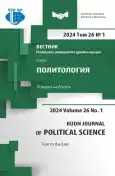Central Asia: Region’s Potential and New Challenges
- 作者: Zhiltsov S.S.1
-
隶属关系:
- The Diplomatic Academy of the Ministry of Foreign Affairs of Russia
- 期: 卷 26, 编号 1 (2024): Turn to the East
- 页面: 78-89
- 栏目: REGIONAL SECURITY AND GEOPOLITICS ISSUES
- URL: https://journal-vniispk.ru/2313-1438/article/view/322447
- DOI: https://doi.org/10.22363/2313-1438-2024-26-1-78-89
- EDN: https://elibrary.ru/OIEODC
- ID: 322447
如何引用文章
详细
Traditionally, Central Asia is associated with a favorable geographical location and significant natural resources. These factors are of interests for the West, Russia, and China in the region. Meanwhile, the potential of Central Asian countries leaves many questions unanswered, as they face many regional challenges. The aim of the study is to identify the geopolitical and economic potential of the Central Asian countries, as well as to identify the challenges that the states have faced in recent years. A special attention is paid to the water and energy issue, which remains the most pressing problem for the whole region. In the conclusion, the author identified two of them: the persistence of economic difficulties in the development of Central Asian countries, which to a certain extent act as economic competitors, as well as the increased influence of extra- regional actors on the countries of the region.
作者简介
Sergey Zhiltsov
The Diplomatic Academy of the Ministry of Foreign Affairs of Russia
编辑信件的主要联系方式.
Email: Serg.serg56@mail.ru
ORCID iD: 0000-0002-4898-2627
SPIN 代码: 4297-7880
Doctor of Political Science, professor, head of the Department of Political
Science and Political Philosophy,
参考
- Berndtsson, R., & Tussupova, K. (2020). The future of water management in Central Asia. Water, 12, 2241. https://doi.org/10.3390/w12082241
- Huseynov, V.A. (Ed.) (2010). Central Asia. Geopolitics and economics of the region. Moscow: A Red Star. (In Russian).
- Dadabaeva, Z.A. (2023). Climate change and water problems of Central Asia in the 21st century: Risks of disintegration. Geoeconomics of Energy, 3, 100–119. (In Russian). http://doi.org/10.48137/26870703_2023_23_3_100
- Granberg, M., & Glover, L. (2023). Climate Change as Societal Risk. Revealing Threats, Reshaping Values. Springer. https://doi.org/10.1007/978-3-031-43961-2
- Gulakhmadov, A., Chen, X., Gulahmadov, N., Liu, T., Davlyatov, R., Sharofiddinov, S., & Gulakhmadov, M. (2020). Long-term hydro-climatic trends in the mountainous Kofarnihon river basin in Central Asia. Water, 12. https://doi.org/10.3390/w12082140
- Hill, A.F., Minbaeva, Ch.K., Wilson, A.M., & Satylkanov, R. (2017). Hydrologic controls and water vulnerabilities in the Naryn River basin, Kyrgyzstan: A socio-hydro case study of water stressors in Central Asia. Water, 9. https://doi.org/10.3390/w9050325
- Ildiz, D. (2015). Transboundary rivers of Afghanistan and regional security. In Afghanistan and regional security issues. Scientific information center of the Interstate Coordination Water Commission of Central Asia (pp. 5–20). Tashkent. (In Russian).
- Karthe, D., Abdullaev, I., Boldgiv, B., Borchardt, D., Chalov, S., Jarsjo, J., Li, L., & Nittrouer, J.A. (2017). Water in Central Asia: an integrated assessment for science-based management. Environ Earth Sci, 76, 1–15. https://doi.org/10.1007/s12665-017-6994-x
- Kasymov, U., & Hamidov, A. (2017). Comparative analysis of nature-related transactions and governance structures in pasture use and irrigation water in Central Asia. Sustainability, 9. https://doi.org/10.3390/su9091633
- Klaptsov, V.M. (2012). Water and energy problems in Central Asia: Causes, difficulties and approaches to resolution. Problems of national strategy, 6, 165–182. (In Russian).
- Kryzhko, E.V., & Pashkovsky, P.I. (2021). Features of the US Foreign Policy towards the Central Asian States. Post-Soviet Issues, 8 (1), 65–81. https://doi.org/10.24975/2313-8920-2021-8-1-65-81 (In Russian).
- Manton, M.J., & Stevenson, L.A. (2014). Climate in Asia and the Pacific. Security, Society and Sustainability. Springer. https://doi.org/10.1007/978-94-007-7338-7
- Maraun, D. (2023). The challenge of providing information about regional climate change. In S. Hummel & et al. (Eds.), Shaping Tomorrow Today — SDGs from multiple perspectives. Springer. https://doi.org/10.1007/978-3-658-38319-0_2
- Nishiaki, Y. (2023). Central Asia. Middle and upper paleolithic sites in the eastern hemisphere, replacement of Neanderthals by modern humans series (pp. 61–67). Springer. https://doi.org/10.1007/978-981-99-3712-7_7
- Yang, Y., Yuanyue, P., Xiang, Y., Zhijie, T., Lingxiao, S., Disse, M., Fanjiang, Z., Yaoming, L., Xi, C., & Ruide, Y. (2019). Climate change, water resources and sustainable development in the arid and semi-arid lands of Central Asia in the past 30 years. Journal of Arid Land, 11 (1), 1–14. https://doi.org/10.1007/s40333-018-0073-3
- Zhiltsov, S.S., & Zonn, I.S. (2008). Fight for water. Safety index, 14(3), 49–62. (In Russian)
- Zhiltsov, S.S., Parkhomchik, L.N., Slizovsky, D.E., & Medvedev, N.P. (2018a). Central Asia at the present stage: A new wave of water-energy cooperation and the creation of pipeline infrastructure. Central Asia and the Caucasus, 21(2), 19–31. (In Russian)
- Zhiltsov, S.S., Zhiltsova, M.S., Medvedev, N.P., & Slizovskiy, D.Y. (2018b). Water resources of Central Asia: Historical overview. In The Handbook of Environmental Chemistry, 85, 9–24.
- Zonn, I.S., Kostianoy, A.G., & Semenov, A.V. (2020). Water resource transfer in Central Asia: Projects, results, and perspectives. Water Resources Management in Central Asia, 105, 47–64.
- Zou, Sh., Jilili, A., Duan, W., De Maeyer, P., & de Voorde, T.V. (2019). Human and natural impacts on the water resources in the Syr Darya river basin, Central Asia. Sustainability, 11, 3084. https://doi.org/10.3390/su11113084
补充文件









